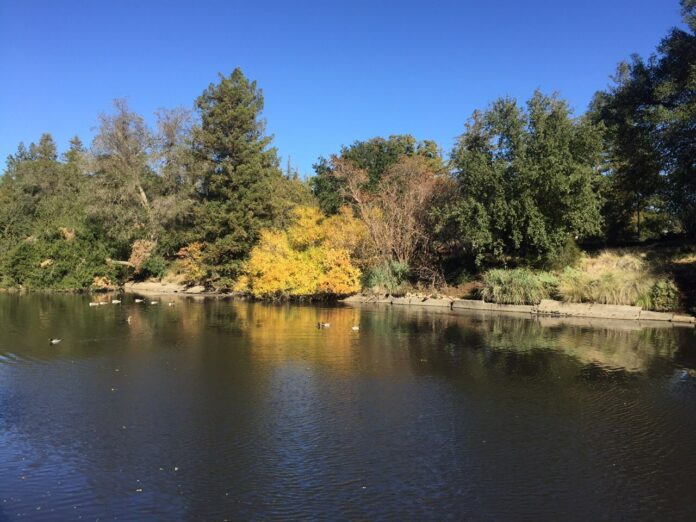Six million waterfowl arrive every winter in California’s “Serengeti migration”
By RACHEL SHEY — city@theaggie.org
Every winter, birders flock to the Davis area to see the native waterfowl populations, according to UC Davis Wildlife, Fish and Conservation Biology faculty Robert Furrow.
“There’s a lot of managed wetlands in the Central Valley, that’s a specialty of the Central Valley in general,” Furrow said. “Historically, the Central Valley used to be a huge wetland in the wintertime. It used to be a riparian forest with big floodplains along the edges of creeks that flooded over and made big marshy areas.”
Now that California is largely developed, these wetlands have vanished. They’ve been replaced by special agricultural measures to ensure habitats for the flocks of migratory waterfowl.
“We don’t have anything like the natural wetlands that would occur anymore, but a lot of agricultural fields are flooded to prevent weed growth,” Furrow said. “It’s super water intensive but simultaneously has an ecological benefit, so it’s often done in conjunction with waterfowl management groups to make sure that there are certain fields flooded in the winter and spring for the ducks and geese.”
Huge flocks of waterfowl travel to the Central Valley every winter from their nesting grounds in Canada, Alaska and as far north as Russia, according to UC Davis Museum of Wildlife and Fish Biology Curator Andrew Engilis Jr.
“This is called the Pacific Flyway,” Engilis said. “There’s probably something around 6 million waterfowl that come and winter here over the course of a year. One of the best places to see them that’s close by Davis is the Yolo Bypass wildlife area. There’s an auto tour route so you can drive around a three or four mile tour route that, if the ponds are flooded, is a great bird watching location.”
The Yolo Bypass Wildlife Area is one of the managed wetlands that Furrow mentioned. It is supplied by the water in Putah Creek, and intended as flood protection for people living in the Yolo Basin. It now has a secondary purpose as a “duck stop” for wild waterfowl to rest up and prepare to raise their young in the spring.
“While it retains its flood-control priority, [the Yolo Bypass Wildlife Area’s] seasonal and permanent ponds have been sculpted from fallow farmland, and they are designed to play a role in reaching the wintering population objective for the Central Valley of 4.7 million waterfowl,” Peter J. Hayes wrote for Outdoor California.
While the species that migrate here are not rare or unusual, such large numbers arrive every winter, which makes their arrival into a fascinating spectacle of nature, Engilis said.
“I think of the Pacific Flyway as California’s Serengeti. In the Serengeti you have wildebeest and zebras that migrate and the predators follow them. It’s kind of similar to here, except the birds are the animals,” Engilis said. “The geese and ducks come down by the hundreds of thousands and the eagles and hawks and falcons follow them down, so they’re here as well. They’re an important component to the migration that we see here in the Central Valley.”
Furrow explained that much of the waterfowl diversity is in ducks.
“In terms of what we actually have breeding here, in most patches of wetland that we have year round, we’ll have mallards,” Furrow said. “And we also have wood ducks along Putah Creek, in part supported by efforts at UC Davis to install a bunch of nesting wood duck boxes along the creek. In winter, we have more than twenty species. You can open a field guide and almost every species of duck, you can find in some number here.”
Geese are also represented in the Davis area. The five common species are widespread in the Pacific Flyway.
“At the Yolo Bypass, you can see snow geese and greater white-fronted geese, sometimes tundra swans, a smaller number of Ross’s geese and cackling geese,” Furrow said.
What’s the difference between geese, ducks and swans? These three main groups of waterfowl generally differ in neck length, with swans having the longest necks, geese having an intermediate neck length and ducks having the shortest necks. They also differ in bill shape; geese tend to have conical bills, whereas ducks have wider, flatter bills, according to Furrow. Furrow also delineated the two categories of ducks.
“Dabbling ducks typically feed on the surface, on vegetation, and they do a sort of upending and pluck on vegetation, browsing and filtering through muddy water,” Furrow said. “That contrasts with diving ducks which typically will be eating animals of some sort, invertebrates, molluscs, some fish [and] amphibians.”
Written by: Rachel Shey — city@theaggie.org




